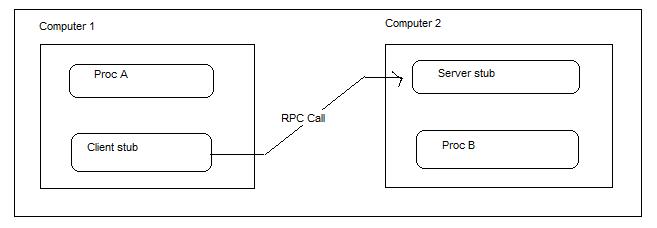一、什么是遠程過程調用
什么是遠程過程調用 RPC(Remote Procedure Call)? 你可能對這個概念有點陌生, 而你可能非常熟悉 NFS, 是的,
NFS 就是基于 RPC 的. 為了理解遠程過程調用,我們先來看一下過程調用。
所謂過程調用,就是將控制從一個過程 A 傳遞到另一個過程 B, 返回時過程 B 將控制進程交給過程 A。目前大多數系統
中, 調用者和被調用者都在給定主機系統中的一個進程中, 它們是在生成可執行文件時由鏈接器連接起來的, 這類過程調用稱
為本地過程調用。
遠程過程調用(RPC)指的是由本地系統上的進程激活遠程系統上的進程, 我們將此稱為過程調用是因為它對程序員來說表現
為常規過程調用。處理遠程過程調用的進程有兩個, 一個是本地客戶進程, 一個是遠程服務器進程。對本地進程來說, 遠程過
程調用表現這對客戶進程的控制, 然后由客戶進程生成一個消息, 通過網絡系統調用發往遠程服務器。網絡信息中包括過程調
用所需要的參數, 遠程服務器接到消息后調用相應過程, 然后將結果通過網絡發回客戶進程, 再由客戶進程將結果返回給調用
進程。因此, 遠程系統調用對調用者表現為本地過程調用, 但實際上是調用了遠程系統上的過程。
二、遠程過程調用模型
本地過程調用: 一個傳統程序由一個或多個過程組成。它們往往按照一種調用等級來安排。如下圖所示:

遠程過程調用: 使用了和傳統過程一樣的抽象, 只是它允許一個過程的邊界跨越兩臺計算機。如下圖所示:

三、遠程過程和本地過程的對比
首先, 網絡延時會使一個遠程過程的開銷遠遠比本地過程要大
其次, 傳統的過程調用因為被調用過程和調用過程運行在同一塊內存空間上, 可以在過程間傳遞指針。而遠程過程不能夠將
指針作為參數, 因為遠程過程與調用者運行在完全不同的地址空間中。
再次, 因為一個遠程調用不能共享調用者的環境, 所以它就無法直接訪問調用者的 I/O 描述符或操作系統功能。
四、遠程過程調用的幾種版本
(1) Sun RPC (UDP, TCP)
(2) Xerox Courier (SPP)
(3) Apollo RPC (UDP, DDS)
其中 Sun RPC 可用于面向連接或非面向連接的協議; Xerox Courier 僅用于面向連接的協議; Apollo RPC 僅用于非連接的協議
五、如何編寫遠程過程調用程序
為了將一個傳統的程序改寫成 RPC 程序, 我們要在程序里加入另外一些代碼, 這個過程稱作 stub 過程。我們可以想象一
個傳統程序, 它的一個過程被轉移到一個遠程機器中。在遠程過程一端, stub 過程取代了調用者。這樣 stub 實現了遠程過
程調用所需要的所有通信。因為 stub 與原來的調用使用了一樣的接口, 因此增加這些 stub 過程既不需要更改原來的調用過
程, 也不要求更改原來的被調用過程。如下圖所示:

六、示例
此示例在 Ubuntu 8.04 + gcc 4.2.3 下編譯運行通過。
遠程過程調用示例(點擊下載)